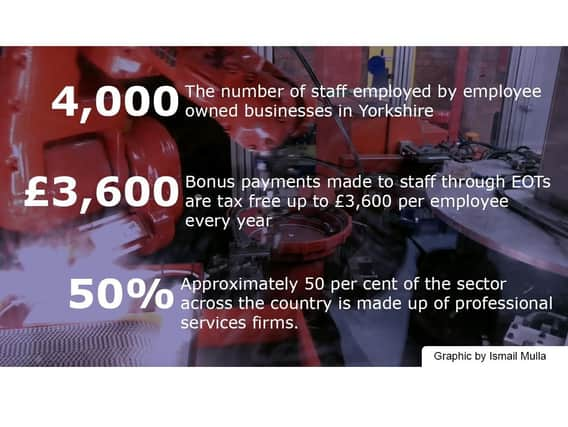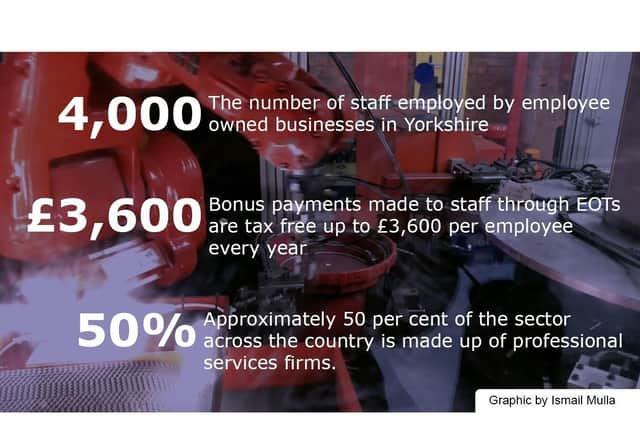Why capitalism is ‘broken’ and how companies such as Gripple, Union Industries and Axis Architecture are leading a new era in business ownership


Back in 1989, Hugh Facey OBE sold his fence making business Estate Wire to concentrate on the wire joining mechanism Gripple.
However, when he sold the business Mr Facey thought it was “wrong” for him to enjoy all the profits from the sale.
Advertisement
Hide AdAdvertisement
Hide AdInstead it was agreed that the company that bought Estate Wire would give 10 per cent of the proceeds bonus to staff who stayed on.


“Those who came with us to Gripple, there were 17 of us, they were given the opportunity to buy shares,” Mr Facey said.
Employee ownership trailblazer
Sheffield-based Gripple today stands as a leading light in the growing sector of employee ownership. The Employee Ownership Association (EOA) says this particular type of business model is currently growing at more than 10 per cent a year.
Gripple has around 700 staff across the world with 550 of those in Sheffield. Every staff member has to buy £1,000 of shares in the company after 12 months of employment.
Advertisement
Hide AdAdvertisement
Hide AdThese shares can be traded every quarter in an internal market that takes into account the performance of the company.
Mr Facey says the underlying motivation for going down this route is “to ensure the business lasts and lasts”.
The straight talking Yorkshireman claims that it is just good business sense being employee owned.
“I would recommend it to anybody,” says Mr Facey, “because it is a fantastic model.”
Advertisement
Hide AdAdvertisement
Hide AdHe added: “I want to get more and more people doing it and committed to it.”
Unlocking trust
There are 17 employee owned businesses in Yorkshire employing 4,000 people, according to the EOA membership database.
Andrew Robinson, accounting and finance professor at Leeds University Business School, runs the White Rose Employee Ownership Centre.
The centre collects data on the growth of employee owned companies and Prof Robinson says this type of business model is increasing “massively” albeit from a low base.
Advertisement
Hide AdAdvertisement
Hide AdHe said: “A lot of it is due to the new legislation in the Finance Act 2014. That helped companies establish something called an Employee Ownership Trust (EOT).”
Trusts provide a Capital Gains Tax exemption when an owner sells a minimum of 51 per cent of the business to an EOT.
Employees can also benefit as bonus payments made through EOTs are tax free up to £3,600 per employee every year.
Doorway to a strong future
Leeds-based Union Industries, which is employee owned through a trust, has just announced a £3,500 bonus for its staff.
Advertisement
Hide AdAdvertisement
Hide AdThe industrial door supplier can trace its roots back to 1795 and when the previous owners Paul and Isobel Schofield, who had acquired the business in 1973, were facing retirement they initially looked at a trade sale.
Andrew Lane, managing director of Union Industries, said: “The former owners had no succession plan. They didn’t have any kids. They looked at selling to venture capitalists and at other forms of trade sale.
“As the conversation starts, it’s all very nice and very friendly but when you get down to the detail words like consolidation, rationalise start creeping in.
“What the former owners realised was that meant the people that had built the business with them were at risk. The culture was also at risk.”
Advertisement
Hide AdAdvertisement
Hide AdMr and Mrs Schofield decided that employee ownership was the best way to cement their legacy and the firm’s long-term future. The couple brought on Mr Lane to oversee the transition.
When it doesn't go well
The managing director of Union Industries had a unique perspective because he had already been involved in an employee owned business, which he says “hadn’t gone that well”.
The reason for that was because the owner of that particular business had made significant cash demands.
Mr Lane said: “The company was really unable to afford to buy him out but it was forced to do so because the alternative was a trade sale.
Advertisement
Hide AdAdvertisement
Hide Ad“When you come to Union Industries, their overriding concern was the continuation of the business.”
Despite being aged 80 at the time of the transaction in 2014, Mr Schofield agreed to a repayment plan lasting 14 years.
The couple also left £1m in the current account to ensure the business had sufficient working capital.
They can be heroes
Mr Lane says the Schofields are “heroes” to those working in the business today because the couple could not only have received more money with a trade sale, they also would have been paid instantly.
Advertisement
Hide AdAdvertisement
Hide AdHe added: “What you’ve got is real benevolent people. They got a cheaper than fair price for the company.
“What they’ve created is a company that will last for as long as it is feasible. In doing so it will create stability for the employees. They get out of it a sense of accomplishment. They’ve created something that will live beyond them.”
Good showing from the service sector
It’s not just the manufacturing sector that is embracing employee ownership.
According to the EOA, approximately 50 per cent of the sector across the country is made up of professional services firms, with 20 per cent of these operating in the fields of architecture and built environment.
Advertisement
Hide AdAdvertisement
Hide AdSheffield-based Axis Architecture is one of those firms. Director Steve Burlaga said the firm, which employs 30 staff, decided to go down this route three years ago.
“This year we’re possibly looking at two directors retiring coming towards the end of the year,” he added.
One of the founding directors, Howard Fry, has already retired and if Tony Brown and Kevin Seers do decided to call it a day, it will leave Mr Burlaga as the sole founding member in the business.
About legacy, not greed
Employee ownership has helped foster a culture of “openness”, “transparency” and “enthusiasm”, according to Mr Burlaga. “When all is said and done you need to enjoy coming to work,” he added.
Advertisement
Hide AdAdvertisement
Hide AdMr Burlaga concedes that a trade sale could have potentially brought in more money for the founders.
He said: “This might sound a bit trite but I wanted to leave a legacy. I’m not a greedy person. Axis has been great to me. I know what I need to live on.
“Money is not a motivator, not that I’ve got masses, but I wanted to leave something as a genuine legacy for people to develop the business and carry on. That’s how all the other directors felt as well.”
Access to capital for the many
French economist Thomas Piketty in his book ‘Capital in the Twenty-First Century’ argued that the rate of return on capital is greater than economic growth over the longer term and this leads to a concentration of wealth in the hands of the few.
Advertisement
Hide AdAdvertisement
Hide AdProf Robinson believes that employee ownership can help make society fairer but it isn’t the sole solution.
He said: “The Piketty argument is that it’s a concentration of wealth and capital. What employee ownership does is it gives employees access to that capital.
“They become part owners or they get some profit share from that company. That gives them some element of wealth redistribution. To me that’s the whole point of it.”
A broken system
Mr Lane thinks that capitalism is “broken” and almost elitist. He said: “Employee ownership in principle breaks that down because it brings in equality.
Advertisement
Hide AdAdvertisement
Hide Ad“When we generate wealth we share that wealth amongst the people who generated it. It’s recognising the value of your human capital and rewarding it accordingly.
“Employee ownership shouldn’t be confused with communism. It’s not. I have the biggest single salary in this company and that’s enough. That pays me to do the job that I do. The rest of it we share.
“The way that capitalism is developing that doesn’t happen. People at the top get the biggest salary, then they get the biggest share of every other distribution going. That can’t be right.”
Tax incentives to get ownership to the many
The Government published an independent review into employee ownership by Graeme Nuttall in 2012. The Nuttall review, which looked at how the Government could create a ‘John Lewis economy’, helped establish EOTs in 2014.
Advertisement
Hide AdAdvertisement
Hide AdEOTs are an indirect employee ownership model. Shares are held on behalf of employees, usually in a trust.
Gripple on the other hand is an example of a direct employee ownership model with staff becoming individual owners of shares.
Companies can also go down the hybrid route, combining individual direct and collective indirect share ownership.
The EOA believes that employee ownership results in better productivity.
Advertisement
Hide AdAdvertisement
Hide AdDeb Oxley OBE, chief executive of the EOA, said: “Evidence shows that employee ownership can deliver better productivity, more engaged employees and supports more resilient regional economies by offering a sustainable succession solution.
“At this time of great political, societal and economic change employee ownership has never been more relevant.”
While employee ownership is increasing, aided by changes in legislation, there is still a lack of awareness of the model.
Gavin Howarth, managing director of HR and employment law firm Howarths, says it’s something that he hasn’t come across despite dealing with nearly 600 small businesses across the region.
He added: “Perhaps it’s a lack of understanding, not knowing that it’s a viable option.”
For more information on Employee Ownership visit https://employeeownership.co.uk/